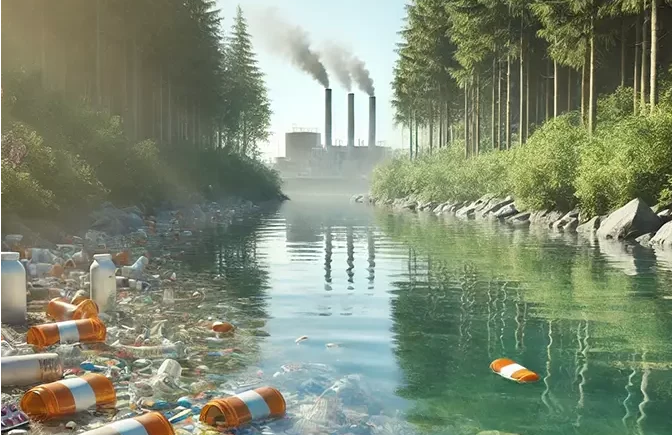Global Trends in Agricultural Waste-Based Bioplastic Research: A Scientometric Review
Downloads
Doi:10.28991/HEF-2025-06-01-015
Full Text:PDF
Downloads
MacLeod, M., Arp, H. P. H., Tekman, M. B., & Jahnke, A. (2021). The global threat from plastic pollution. Science, 373(6550), 61–65. doi:10.1126/science.abg5433.
Zhang, L., He, Y., Jiang, L., Shi, Y., Hao, L., Huang, L., Lyu, M., & Wang, S. (2024). Plastic additives as a new threat to the global environment: Research status, remediation strategies and perspectives. Environmental Research, 263, 120007. doi:10.1016/j.envres.2024.120007.
Singh, S., & Li, S. S. L. (2013). Epigenetic effects of environmental chemicals Bisphenol A and Phthalates. Epigenetics and Pathology: Exploring Connections between Genetic Mechanisms and Disease Expression, 13, 267–278. doi:10.1201/b16304.
Putri, V. A., Arto, K. S., Lubis, A. D., Dangana, A., & Chiu, Y. H. (2024). Relationship between urinary bisphenol A and age at menarche among adolescent girls: A study in Sumatera Utara Province, Indonesia. Narra X, 2(2), e161-e161. doi:10.52225/narrax.v2i2.161.
Van Raamsdonk, L. W. D., Van Der Zande, M., Koelmans, A. A., Hoogenboom, P. L. A., Peters, R. J. B., Groot, M. J., Peijnenburg, M. A. C., & Weesepoel, Y. J. A. (2020). Current insights into monitoring, bioaccumulation, and potential health effects of microplastics present in the food chain. Foods, 9(1), 72. doi:10.3390/foods9010072.
Parolini, M., Stucchi, M., Ambrosini, R., & Romano, A. (2023). A global perspective on microplastic bioaccumulation in marine organisms. Ecological Indicators, 149, 110179. doi:10.1016/j.ecolind.2023.110179.
Miller, M. E., Hamann, M., & Kroon, F. J. (2020). Bioaccumulation and biomagnification of microplastics in marine organisms: A review and meta-analysis of current data. PLoS ONE, 15(10), 240792. doi:10.1371/journal.pone.0240792.
Kan, M., & Miller, S. A. (2022). Environmental impacts of plastic packaging of food products. Resources, Conservation and Recycling, 180, 106156. doi:10.1016/j.resconrec.2022.106156.
Ahamed, A., Veksha, A., Giannis, A., & Lisak, G. (2021). Flexible packaging plastic waste – environmental implications, management solutions, and the way forward. Current Opinion in Chemical Engineering, 32, 100684. doi:10.1016/j.coche.2021.100684.
Mama, C. N., Nnaji, C. C., Nnam, J. P., & Opata, O. C. (2021). Environmental burden of unprocessed solid waste handling in Enugu State, Nigeria. Environmental Science and Pollution Research, 28(15), 19439–19457. doi:10.1007/s11356-020-12265-y.
Upcraft, T., Tu, W. C., Johnson, R., Finnigan, T., Van Hung, N., Hallett, J., & Guo, M. (2021). Protein from renewable resources: Mycoprotein production from agricultural residues. Green Chemistry, 23(14), 5150–5165. doi:10.1039/d1gc01021b.
Babu, S., Singh Rathore, S., Singh, R., Kumar, S., Singh, V. K., Yadav, S. K., Yadav, V., Raj, R., Yadav, D., Shekhawat, K., & Ali Wani, O. (2022). Exploring agricultural waste biomass for energy, food and feed production and pollution mitigation: A review. Bioresource Technology, 360, 127566. doi:10.1016/j.biortech.2022.127566.
Wang, N., He, Y., Zhao, K., Lin, X., He, X., Chen, A., Wu, G., Zhang, J., Yan, B., Luo, L., & Xu, D. (2024). Greenhouse gas emission characteristics and influencing factors of agricultural waste composting process: A review. Journal of Environmental Management, 354, 120337. doi:10.1016/j.jenvman.2024.120337.
Azieyanti, N. A., Amirul, A., Othman, S. Z., & Misran, H. (2020). Mechanical and Morphology Studies of Bioplastic-Based Banana Peels. Journal of Physics: Conference Series, 1529(3), 32091. doi:10.1088/1742-6596/1529/3/032091.
Ramadhan, M. O., & Handayani, M. N. (2020). The potential of food waste as bioplastic material to promote environmental sustainability: A review. IOP Conference Series: Materials Science and Engineering, 980(1), 12082. doi:10.1088/1757-899X/980/1/012082.
Abdul Rahman, W. (2023). Bioplastic from Peel and Rind of Tropical Fruits in Southeast Asia: A Mini-Review. Scientific Research Journal, 20, 55–74. doi:10.24191/srj.v20is.23298.
Rajesh, Y., Gautam, N., Saloni, P., Deore, V., Shivde, P., & Dabhade, G. (2024). Agricultural resources in focus: Eco-friendly bioplastic synthesis from corn starch. In Materials Today: Proceedings. Proceedings. doi:10.1016/j.matpr.2024.01.025.
Bello, T. K., Eze, E. C., Usman, M. S., & Isa, M. T. (2024). Characterization of bioplastics produced from yam and potato peels using hydrochloric and acetic acids. Biomass Conversion and Biorefinery, 14(15), 18019–18030. doi:10.1007/s13399-023-04021-2.
Chaffa, T. Y., Meshesha, B. T., Mohammed, S. A., & Jabasingh, S. A. (2022). Production, characterization, and optimization of starch-based biodegradable bioplastic from waste potato (Solanum tuberosum) peel with the reinforcement of false banana (Ensete ventricosum) fiber. Biomass Conversion and Biorefinery, 14, 27365–27377. doi:10.1007/s13399-022-03426-9.
Hossain, M. T., Shahid, M. A., Akter, S., Ferdous, J., Afroz, K., Refat, K. R. I., Faruk, O., Jamal, M. S. I., Uddin, M. N., & Samad, M. A. Bin. (2024). Cellulose and starch-based bioplastics: a review of advances and challenges for sustainability. Polymer-Plastics Technology and Materials, 63(10), 1329–1349. doi:10.1080/25740881.2024.2329980.
Jayarathna, S., Andersson, M., & Andersson, R. (2022). Recent Advances in Starch-Based Blends and Composites for Bioplastics Applications. Polymers, 14(21), 4557. doi:10.3390/polym14214557.
Tan, S. X., Andriyana, A., Ong, H. C., Lim, S., Pang, Y. L., & Ngoh, G. C. (2022). A Comprehensive Review on the Emerging Roles of Nanofillers and Plasticizers towards Sustainable Starch-Based Bioplastic Fabrication. Polymers, 14(4), 664. doi:10.3390/polym14040664.
Li, H., Zhou, M., Mohammed, A. E. G. A. Y., Chen, L., & Zhou, C. (2022). From fruit and vegetable waste to degradable bioplastic films and advanced materials: A review. Sustainable Chemistry and Pharmacy, 30, 100859. doi:10.1016/j.scp.2022.100859.
Gupta, S., Kaur, A., & Ghoshal, G. (2024). Sustainable Packaging Solution from Agriculture Waste: Production of Bioplastic, Biocomposite, Biopolymer. Transforming Agriculture Residues for Sustainable Development: From Waste to Wealth. Springer, 245–272. doi:10.1007/978-3-031-61133-9_11.
Baijua, P., Mukkadan, M. J., & Radhakrishnan, P. (2024). Husk and Straw of Cereals Grains for Sustainable Food Packaging. Agro-Waste Derived Biopolymers and Biocomposites: Innovations and Sustainability in Food Packaging. Wiley, 153–186. doi:10.1002/9781394175161.ch6.
Ilyas, R. A., Sapuan, S. M., Ishak, M. R., Zainudin, E. S., & Atikah, M. S. N. (2018). Characterization of Sugar Palm Nanocellulose and Its Potential for Reinforcement with a Starch-Based Composite. In Sugar Palm Biofibers, Biopolymers, and Biocomposites (pp. 189–220). CRC Press. doi:10.1201/9780429443923-10.
Otoni, C. G., Azeredo, H. M. C., Mattos, B. D., Beaumont, M., Correa, D. S., & Rojas, O. J. (2021). The Food–Materials Nexus: Next Generation Bioplastics and Advanced Materials from Agri-Food Residues. Advanced Materials, 33(43), 2102520. doi:10.1002/adma.202102520.
Vigneswari, S., Kee, S. H., Hazwan, M. H., Ganeson, K., Tamilselvan, K., Bhubalan, K., Amirul, A. A., & Ramakrishna, S. (2024). Turning agricultural waste streams into biodegradable plastic: A step forward into adopting sustainable carbon neutrality. Journal of Environmental Chemical Engineering, 12(2), 112135. doi:10.1016/j.jece.2024.112135.
Choudhary, P., Pathak, A., Kumar, P., S, C., & Sharma, N. (2024). Commercial production of bioplastic from organic waste–derived biopolymers viz-a-viz waste treatment: A minireview. Biomass Conversion and Biorefinery, 14(10), 10817–10827. doi:10.1007/s13399-022-03145-1.
Mandal, M., Roy, A., Mitra, D., & Sarkar, A. (2024). Possibilities and prospects of bioplastics production from agri-waste using bacterial communities: Finding a silver-lining in waste management. Current Research in Microbial Sciences, 7, 100274. doi:10.1016/j.crmicr.2024.100274.
Chauhan, K., Kaur, R., & Chauhan, I. (2024). Sustainable bioplastic: a comprehensive review on sources, methods, advantages, and applications of bioplastics. Polymer-Plastics Technology and Materials, 63(8), 913–938. doi:10.1080/25740881.2024.2307369.
Riseh, R. S., Vazvani, M. G., Hassanisaadi, M., & Thakur, V. K. (2024). Agricultural wastes: A practical and potential source for the isolation and preparation of cellulose and application in agriculture and different industries. Industrial Crops and Products, 208, 117904. doi:10.1016/j.indcrop.2023.117904.
Iqhrammullah, M., Chiari, W., Hudaa, S., Irhamni, I., Fahrurrozi, & Akbar, S. A. (2024). Microalgal”bacterial interactions: Research trend and updated review. Heliyon, 10(15), e35324. doi:10.1016/j.heliyon.2024.e35324.
Pratama, Y. A., Kadir, M. Y. A., Rivaldi, A., Mulya, I. C., Amirah, S., & Iqhrammullah, M. (2024). Bibliometric analysis of the impact of environmental degradation on women and the importance of women's representation. Global Journal of Environmental Science and Management, 10(3), 939–954. doi:10.22034/gjesm.2024.03.01.
Passas, I. (2024). Bibliometric Analysis: The Main Steps. Encyclopedia, 4(2), 1014–1025. doi:10.3390/encyclopedia4020065.
Chiari, W., Damayanti, R., Harapan, H., Puspita, K., Saiful, S., Rahmi, R., Rizki, D. R., & Iqhrammullah, M. (2022). Trend of Polymer Research Related to COVID-19 Pandemic: Bibliometric Analysis. Polymers, 14(16), 3297. doi:10.3390/polym14163297.
Kresnowati, L., Suhartono, S., Shaluhiyah, Z., & Widjanarko, B. (2024). Finding the new potential research on diabetic kidney disease and hemodialysis in healthcare insurance databases: A bibliometric analysis. Narra J, 4(3), 827– 827. doi:10.52225/narra.v4i3.827.
Chiari, W., Amirah, S., Lemu, Y. K., Subbaram, K., Edwards, R. J., Kretchy, J.-P., Vento, S., Khader, Y., & Rademaker, M. (2024). Trends in publication and collaboration of health-themed systematic reviews before and during the COVID-19 pandemic: A bibliometric study. Narra X, 2(1), e106. doi:10.52225/narrax.v2i1.106.
Ginting, B., Chiari, W., Duta, T. F., Hudaa, S., Purnama, A., Harapan, H., Rizki, D. R., Puspita, K., Idroes, R., Meriatna, M., & Iqhrammullah, M. (2023). COVID-19 pandemic sheds a new research spotlight on antiviral potential of essential oils – A bibliometric study. Heliyon, 9(7), e17703. doi:10.1016/j.heliyon.2023.e17703.
Cheng, K., Li, Z., Sun, Z., Guo, Q., Li, W., Lu, Y., Qi, S., Shen, Z., Xie, R., Wang, Y., Wu, Z., Wu, Y., Wu, C., Li, Y., Xie, Y., Wu, H., & Li, C. (2024). The rapid growth of bibliometric studies: a call for international guidelines. International Journal of Surgery (London, England), 110(4), 2446–2448. doi:10.1097/JS9.0000000000001049.
Aria, M., & Cuccurullo, C. (2017). bibliometrix: An R-tool for comprehensive science mapping analysis. Journal of Informetrics, 11(4), 959–975. doi:10.1016/j.joi.2017.08.007.
van Eck, N. J., & Waltman, L. (2014). Visualizing Bibliometric Networks. Measuring Scholarly Impact: Springer, 285–320. doi:10.1007/978-3-319-10377-8_13.
Iqhrammullah, M., Refin, R. Y., Rasmi, R. I., Andika, F. F., Hajjah, H., Marlina, M., & Ningsih, R. (2023). Cancer in Indonesia: A bibliometric surveillance. Narra X, 1(2), 86. doi:10.52225/narrax.v1i2.86.
Ahmad, K., & Chiari, W. (2023). Metal oxide/chitosan composite for organic pollutants removal: A comprehensive review with bibliometric analysis. Narra X, 1(2), 91. doi:10.52225/narrax.v1i2.91.
Japri, N. F., Majid, Z. A., Ghoshal, S. K., Danial, W. H., See, H. H., & Othman, M. Z. (2024). On the versatility of graphene-cellulose composites: An overview and bibliometric assessment. Carbohydrate Polymers, 337, 121969. doi:10.1016/j.carbpol.2024.121969.
González-Arancibia, F., Mamani, M., Valdés, C., Contreras-Matté, C., Pérez, E., Aguilera, J., Rojas, V., Ramirez-Malule, H., & Andler, R. (2024). Biopolymers as Sustainable and Active Packaging Materials: Fundamentals and Mechanisms of Antifungal Activities. Biomolecules, 14(10), 1224. doi:10.3390/biom14101224.
Sari, D. kartika, Wardhani, D. H., & Sumardiono, S. (2024). Bibliometric mapping of cellulose nanoparticle research (2013–2023) using VOSviewer. Egyptian Journal of Chemistry, 67(10), 87–96. doi:10.21608/ejchem.2024.258587.9095.
Oliveira, J. P. de, Silva, I. B. da, Costa, J. da S. S., Oliveira, J. S. de, Oliveira, E. L., Coutinho, M. L., Almeida, M. E. F. de, Landim, L. B., Silva, N. M. C. da, & Oliveira, C. P. de. (2024). Bibliometric study and potential applications in the development of starch films with nanocellulose: A perspective from 2019 to 2023. International Journal of Biological Macromolecules, 277, 133828. doi:10.1016/j.ijbiomac.2024.133828.
M. Amin, M. A., Mohd Omar, S., Kamal Bashah, M. H., Mohd Nasir, M. H., & Wan Abdul Khodir, W. K. (2024). Bibliometric Analysis of the Use of Electrospun Chitosan Nanofibers in Biomedical Applications. Journal of Sustainable Materials Processing and Management, 4(1), 1–12.
Samer, M., Hijazi, O., Mohamed, B. A., Abdelsalam, E. M., Amer, M. A., Yacoub, I. H., Attia, Y. A., & Bernhardt, H. (2022). Environmental impact assessment of bioplastics production from agricultural crop residues. Clean Technologies and Environmental Policy, 24(3), 815–827. doi:10.1007/s10098-021-02145-5.
Mirpoor, S. F., Giosafatto, C. V. L., & Porta, R. (2021). Biorefining of seed oil cakes as industrial co-streams for production of innovative bioplastics. A review. Trends in Food Science and Technology, 109, 259–270. doi:10.1016/j.tifs.2021.01.014.
Chowdhury, M. A., Nayem Hossain, Badrudduza, M. D., & Rana, M. M. (2023). Development and characterization of natural sourced bioplastic for food packaging applications. Heliyon, 9(2), e13538. doi:10.1016/j.heliyon.2023.e13538.
Tan, S. X., Ong, H. C., Andriyana, A., Lim, S., Pang, Y. L., Kusumo, F., & Ngoh, G. C. (2022). Characterization and Parametric Study on Mechanical Properties Enhancement in Biodegradable Chitosan-Reinforced Starch-Based Bioplastic Film. Polymers, 14(2), 278. doi:10.3390/polym14020278.
Merino, D., Simonutti, R., Perotto, G., & Athanassiou, A. (2021). Direct transformation of industrial vegetable waste into bioplastic composites intended for agricultural mulch films. Green Chemistry, 23(16), 5956–5971. doi:10.1039/d1gc01316e.
Mujtaba, M., Fernandes Fraceto, L., Fazeli, M., Mukherjee, S., Savassa, S. M., Araujo de Medeiros, G., do Espírito Santo Pereira, A., Mancini, S. D., Lipponen, J., & Vilaplana, F. (2023). Lignocellulosic biomass from agricultural waste to the circular economy: a review with focus on biofuels, biocomposites and bioplastics. Journal of Cleaner Production, 402, 136815. doi:10.1016/j.jclepro.2023.136815.
Zhang, H., Su, Z., & Wang, X. (2022). Starch-Based Rehealable and Degradable Bioplastic Enabled by Dynamic Imine Chemistry. ACS Sustainable Chemistry and Engineering, 10(26), 8650–8657. doi:10.1021/acssuschemeng.2c02537.
Vedove, T. M. A. R. D., Maniglia, B. C., & Tadini, C. C. (2021). Production of sustainable smart packaging based on cassava starch and anthocyanin by an extrusion process. Journal of Food Engineering, 289, 110274. doi:10.1016/j.jfoodeng.2020.110274.
Yao, X., Qin, Y., Zhang, M., Zhang, J., Qian, C., & Liu, J. (2021). Development of active and smart packaging films based on starch, polyvinyl alcohol and betacyanins from different plant sources. International Journal of Biological Macromolecules, 183, 358–368. doi:10.1016/j.ijbiomac.2021.04.152.
Mahovič Poljaček, S., Tomašegovič, T., Strižič Jakovljevič, M., Jamnicki Hanzer, S., Murkovič Steinberg, I., Žuvič, I., Leskovac, M., Lavrič, G., Kavčič, U., & Karlovits, I. (2024). Starch-Based Functional Films Enhanced with Bacterial Nanocellulose for Smart Packaging: Physicochemical Properties, pH Sensitivity and Colorimetric Response. Polymers, 16(16), 2259. doi:10.3390/polym16162259.
Alrimawi, B. H., Chan, M. Y., Ooi, X. Y., Chan, S. Y., & Goh, C. F. (2021). The interplay between drug and sorbitol contents determines the mechanical and swelling properties of potential rice starch films for buccal drug delivery. Polymers, 13(4), 1–15. doi:10.3390/polym13040578.
Ahmed, A., Niazi, M. B. K., Jahan, Z., Samin, G., Pervaiz, E., Hussain, A., & Mehran, M. T. (2020). Enhancing the Thermal, Mechanical and Swelling Properties of PVA/Starch Nanocomposite Membranes Incorporating g-C3N4. Journal of Polymers and the Environment, 28(1), 100–115. doi:10.1007/s10924-019-01592-y.
Nazaruddin, N., Afifah, N., Bahi, M., Susilawati, S., Sani, N. D. M., Esmaeili, C., Iqhrammullah, M., Murniana, M., Hasanah, U., & Safitri, E. (2021). A simple optical pH sensor based on pectin and Ruellia tuberosa L-derived anthocyanin for fish freshness monitoring. In F1000Research (Vol. 10, p. 422). doi:10.12688/f1000research.52836.2.
Safitri, E., Nazaruddin, N., Nurhayati, Aldiansyah, T., Khalid, W. E. F. W., Nazaruddin, S. L., Bahi, M., & Iqhrammullah, M. (2024). Optical urea biosensor based on polyelectrolyte complex (PEC) pectin-chitosan membrane and anthocyanin from Catharanthus roseus L for a salivary simple urea detection. Results in Chemistry, 7. doi:10.1016/j.rechem.2024.101340.
Faradilla, R. F., Risaldi, Tamrin, T. A. M., Salfia, Rejeki, S., Rahmi, A., & Arcot, J. (2022). Low energy and solvent free technique for the development of nanocellulose based bioplastic from banana pseudostem juice. Carbohydrate Polymer Technologies and Applications, 4, 100261. doi:10.1016/j.carpta.2022.100261.
Boey, J. Y., Lee, C. K., & Tay, G. S. (2022). Factors Affecting Mechanical Properties of Reinforced Bioplastics: A Review. Polymers, 14(18), 3737. doi:10.3390/polym14183737.
La Fuente Arias, C. I., Kubo, M. T. K. neiwa, Tadini, C. C., & Augusto, P. E. D. (2023). Bio-based multilayer films: A review of the principal methods of production and challenges. Critical Reviews in Food Science and Nutrition, 63(14), 2260–2276. doi:10.1080/10408398.2021.1973955.
Rajeshkumar, L., Ramesh, M., Bhuvaneswari, V., Balaji, D., & Deepa, C. (2023). Synthesis and thermomechanical properties of bioplastics and biocomposites: a systematic review. Journal of Materials Chemistry B, 11(15), 3307–3337. doi:10.1039/d2tb02221d.
Chong, T. Y., Law, M. C., & Chan, Y. S. (2021). The Potentials of Corn Waste Lignocellulosic Fibre as an Improved Reinforced Bioplastic Composites. Journal of Polymers and the Environment, 29(2), 363–381. doi:10.1007/s10924-020-01888-4.
Feng, Y., Zhang, D., Liang, Y., Yin, X., & Lei, B. (2021). A facile strategy for preparing lignocellulose-based bioplastic by grafting with quaternary ammonium salts. Industrial Crops and Products, 174, 114160. doi:10.1016/j.indcrop.2021.114160.
Ilyas, R. A., Azmi, A., Nurazzi, N. M., Atiqah, A., Atikah, M. S. N., Ibrahim, R., Norrrahim, M. N. F., Asyraf, M. R. M., Sharma, S., Punia, S., Syafri, E., Sari, N. H., Asrofi, M., & Sapuan, S. M. (2021). Oxygen permeability properties of nanocellulose reinforced biopolymer nanocomposites. Materials Today: Proceedings, 52, 2414–2419. doi:10.1016/j.matpr.2021.10.420.
Li, H., Zeng, X., Yao, T., & Xu, H. (2024). An antimicrobial film of silver/nanocellulose crystal/oxalic acid/polyvinyl alcohol with real-time bactericidal and prevention of biofilm formation properties. Colloids and Surfaces B: Biointerfaces, 237, 113868. doi:10.1016/j.colsurfb.2024.113868.
Ghosh, S., Sarkar, T., & Chakraborty, R. (2021). Formation and development of biofilm- an alarming concern in food safety perspectives. Biocatalysis and Agricultural Biotechnology, 38, 102210. doi:10.1016/j.bcab.2021.102210.
Schutz, G. F., de ívila Gonçalves, S., Alves, R. M. V., & Vieira, R. P. (2024). A review of starch-based biocomposites reinforced with plant fibers. International Journal of Biological Macromolecules, 261, 129916. doi:10.1016/j.ijbiomac.2024.129916.
Bangar, S. P., Whiteside, W. S., Chowdhury, A., Ilyas, R. A., & Siroha, A. K. (2024). Recent advancements in functionality, properties, and applications of starch modification with stearic acid: A review. International Journal of Biological Macromolecules, 280, 135782. doi:10.1016/j.ijbiomac.2024.135782.
Ahmed, M. J., Ashfaq, J., Sohail, Z., Channa, I. A., Sánchez-Ferrer, A., Ali, S. N., & Chandio, A. D. (2024). Lignocellulosic bioplastics in sustainable packaging – Recent developments in materials design and processing: A comprehensive review. Sustainable Materials and Technologies, 41, 1077. doi:10.1016/j.susmat.2024.e01077.
Zhang, J., Fu, S., Hu, C., Yuan, X., & Zhou, X. (2025). Strong and tough bioplastics prepared by in-situ polymerization of ε–caprolactone-oligomers in lignocellulosic nanofiber network. International Journal of Biological Macromolecules, 293, 138890. doi:10.1016/j.ijbiomac.2024.138890.
Yu, S., Sun, J., Shi, Y., Wang, Q., Wu, J., & Liu, J. (2021). Nanocellulose from various biomass wastes: Its preparation and potential usages towards the high value-added products. Environmental Science and Ecotechnology, 5, 100077. doi:10.1016/j.ese.2020.100077.
Mateo, S., Peinado, S., Morillas-Gutiérrez, F., La Rubia, M. D., & Moya, A. J. (2021). Nanocellulose from agricultural wastes: Products and applications”A review. Processes, 9(9), 1594. doi:10.3390/pr9091594.
- The authors retain all copyrights. It is noticeable that authors will not be forced to sign any copyright transfer agreements.
- This work (including HTML and PDF Files) is licensed under a Creative Commons Attribution 4.0 International License.














